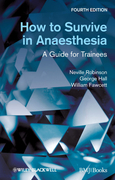
Many trainees in anaesthesia approach the clinical year with trepidation. Ofall the medical specialties this is arguably the most intimidating how do youput in a line without breaking a vein; indeed, how do you find the vein? Howdo you assess the patient accurately so as to avoid life threatening mistakeswith the analgesics? How do you perform a tracheal intubation? These and other nerve-wracking scenarios confront trainees as soon as they start their practical year. Yet the basics of anaesthetic practice are not part of the early curriculum; they are a learning on the job experience. How to Survive in Anaesthesia was written to answer the questions that newly qualified anaesthetists need answers to but may be too embarrassed to ask. Through three editions its popularity has gathered momentum across the globe. Now the fourth edition has been revised and updated, responding to changes in practice and new requirements. New features for this edition include: A new introduction on the theatre environment A new chapter on local anaesthetic toxicity The latest guidelines on intravenous fluids Updated information on airway procedures and equipment Written in an easy, humorous style by leading anaesthetists who have over 90 years experience between them, this book is the junior anaesthetists gateway to sound authoritative advice on how to perform anaesthetics in real life. It will inspire confidence in any new doctor starting in the specialty. INDICE: List of boxes. List of figures. List of tables. Preface to the fourth edition. Preface to the third edition. Preface to the second edition. Preface to the first edition. Lets start at the very beginning. Part I Nuts and bolts. Chapter 1: Evaluation of the airway. Chapter 2: Control of the airway. Chapter 3: Tracheal intubation. Chapter 4: Failed intubation drill. Chapter 5: Vascular access. Chapter 6: Intravenous fluids. Chapter 7: The anaesthetic machine. Chapter 8: Anaesthetic breathing systems. Chapter 9: Ventilators and other equipment. Chapter 10: Monitoring in anaesthesia. Part II Crises and complications. Chapter 11: Cardiac arrest. Chapter 12: Haemorrhage and blood transfusion. Chapter 13: Anaphylactic reactions. Chapter 14: Malignant hyperthermia. Chapter 15: Local anaesthetic toxicity. Chapter 16: Stridor upper airway obstruction. Chapter 17: Pneumothorax. Chapter 18: Common intraoperative problems. Chapter 19: Postoperative problems. Chapter 20: Anaesthetic mishaps. Part III Passing the gas. Chapter 21: Preoperative evaluation. Chapter 22: Recognition and management of the sick patient. Chapter 23: Principles of emergency anaesthesia. Chapter 24: Epidural and spinal anaesthesia. Chapter 25: Anaesthesia forgynaecological surgery. Chapter 26: Anaesthesia for urological surgery. Chapter 27: Anaesthesia for abdominal surgery. Chapter 28: Anaesthesia for dental and ENT surgery. Chapter 29: Anaesthesia for orthopaedic surgery. Chapter 30: Anaesthesia for day case surgery. Chapter 31: Management of the patient in the recovery area. Chapter 32: Postoperative analgesia. Chapter 33: Management of head injuries. Chapter 34: Anaesthesia in the corridor. Chapter 35: Anaesthetic aphorisms. And finally. Index.
- ISBN: 978-0-470-65462-0
- Editorial: John Wiley & Sons
- Encuadernacion: Rústica
- Páginas: 252
- Fecha Publicación: 18/11/2011
- Nº Volúmenes: 1
- Idioma: Inglés
